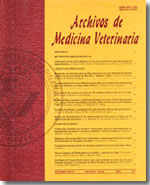Comparative study of the canine prostate using transrectal and transabdominal ultrasonographic techniques
Main Article Content
Abstract
The purpose of this study was to compare the use of transrectal and transabdominal ultrasonographic techniques for the examination of the canine prostate gland. Twenty healthy male dogs, from 1.5 to 10 years old, weighing between 15 and 35 kg were used. They were anesthetised intravenously with Xylazine and Ketamine. The transrectal ultrasound was performed using a 7.5 MHz linear transducer and the transabdominal ultrasound with a 7.5 MHz sector transducer. The parameters compared with both techniques were: detection of the prostate gland, its length, width echogenicity and echotexture. The transrectal technique allowed the detection of the prostate gland in all cases. The transabdominal technique achieved 4 complete images, 11 incomplete images and in 5 cases the prostatic gland was not detected at all. Significant differences in prostatic length and width were found comparing both techniques. The gland was longer with the transrectal technique and wider with the transabdominal method. There were no differences between both techniques when comparing the echogenicity and echotexture. However the obtained image detail was better with the transrectal technique. It can be concluded that the transrectal technique gives better information regarding prostatic size than the transabdominal technique. The transrectal technique is rarely used, because a rectal probe and general anesthesia are required. In dogs, both techniques are important and complementary in order to determine prostatic image.

